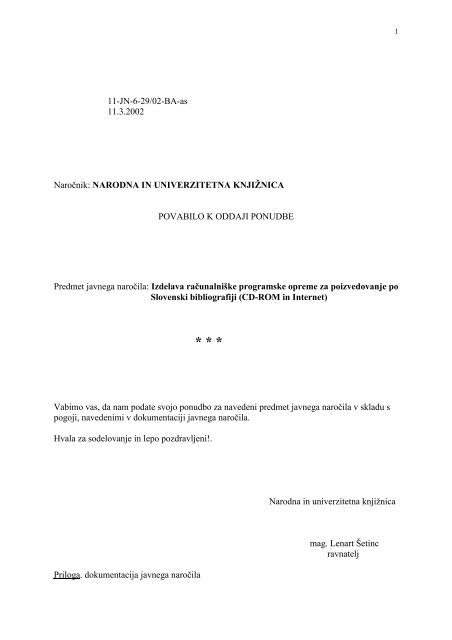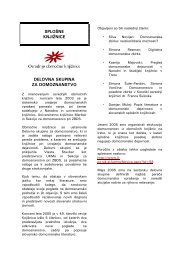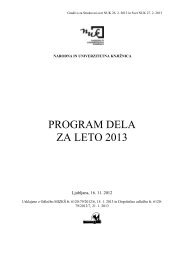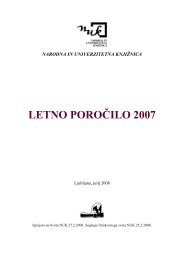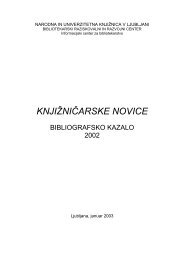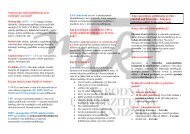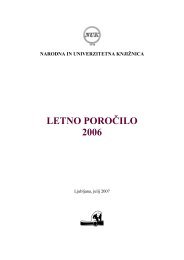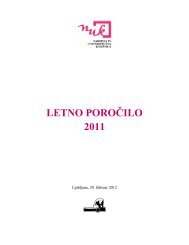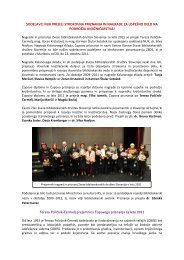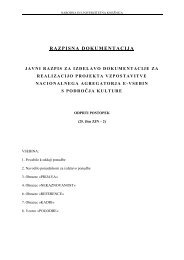Pdf datoteka - Narodna in univerzitetna knjižnica
Pdf datoteka - Narodna in univerzitetna knjižnica
Pdf datoteka - Narodna in univerzitetna knjižnica
Create successful ePaper yourself
Turn your PDF publications into a flip-book with our unique Google optimized e-Paper software.
1<br />
11-JN-6-29/02-BA-as<br />
11.3.2002<br />
Naročnik: NARODNA IN UNIVERZITETNA KNJIŽNICA<br />
POVABILO K ODDAJI PONUDBE<br />
Predmet javnega naročila: Izdelava računalniške programske opreme za poizvedovanje po<br />
Slovenski bibliografiji (CD-ROM <strong>in</strong> Internet)<br />
* * *<br />
Vabimo vas, da nam podate svojo ponudbo za navedeni predmet javnega naročila v skladu s<br />
pogoji, navedenimi v dokumentaciji javnega naročila.<br />
Hvala za sodelovanje <strong>in</strong> lepo pozdravljeni!.<br />
<strong>Narodna</strong> <strong>in</strong> <strong>univerzitetna</strong> knjižnica<br />
Priloga. dokumentacija javnega naročila<br />
mag. Lenart Šet<strong>in</strong>c<br />
ravnatelj
2<br />
NARODNA IN UNIVERZITETNA KNJIŽNICA,<br />
Ljubljana, Turjaška 1<br />
J A V N O N A R O Č I L O M A L E V R E D N O S T I<br />
DOKUMENTACIJA JAVNEGA NAROČILA<br />
za izbiro izvajalca za izdelavo računalniške programske opreme<br />
za poizvedovanje po Slovenski bibliografiji (CD-ROM <strong>in</strong> Internet)<br />
VSEBINA:<br />
1. NAVODILO PONUDNIKOM ZA IZDELAVO PONUDBE<br />
2. PONUDBA (obr. JN-5)<br />
3. IZJAVA O SPREJEMANJU IN IZPOLNJEVANJU POGOJEV JAVNEGA NAROČILA<br />
(obr. JN-7)<br />
4. REFERENCE (obr. JN-8)<br />
5. PROGRAM DEL - METODOLOŠKI PRISTOP (obr. JN-9)<br />
6. VZOREC POGODBE (obr. JN-10)<br />
7. PRILOGA A (opis programa)
3<br />
NAVODILO PONUDNIKOM ZA<br />
IZDELAVO PONUDBE<br />
I.<br />
Predmet tega javnega naročila je izdelava računalniške programske opreme za poizvedovanje<br />
po Slovenski bibliografiji (CD-ROM <strong>in</strong> Internet).<br />
Struktura, specifikacije, opisi <strong>in</strong> druge zahteve naročnika v zvezi s programsko opremo so<br />
navedeni v prilogi A.<br />
Priročniki standardov (UNIMARC, Slovenska bibliografija na CD-ROMu s priročnikom itd.)<br />
so ponudnikom na voljo v Informacijskem centru za bibliotekarstvo (INDOK) naročnika vsak<br />
delavnik od 9. - 13. ure.<br />
II.<br />
Predmet javnega naročila ni razdeljen na samostojne sklope <strong>in</strong> zato ponudniki lahko oddajo<br />
veljavno ponudbo le za izdelavo celotne programske opreme (POGOJ).<br />
III.<br />
Programska oprema mora upoštevati uveljavljene standardne rešitve <strong>in</strong> izpolnjevati naslednje<br />
pogoje:<br />
• okolje W<strong>in</strong>dows 2000<br />
• Microsoft SQL<br />
• podpora standarda UNIMARC<br />
• podpora standarda XML<br />
• možnost dograjevanja, sprem<strong>in</strong>janja <strong>in</strong> dodatnega razvoja<br />
• izvorna koda <strong>in</strong> dokumentacija morata biti pripravljeni na nač<strong>in</strong>, ki bo omogočal<br />
nadgradnjo <strong>in</strong> vzdrževanje programske opreme tudi tretjim osebam, čeprav bo pod<br />
enakimi pogoji pri tem imel prednost izbrani ponudnik.
4<br />
IV.<br />
Ponudnik lahko dobi vse <strong>in</strong>formacije v zvezi s predmetom javnega naročila na podlagi<br />
pisnega zaprosila do izteka roka za oddajo ponudbe.<br />
Odgovore na vprašanja <strong>in</strong> pojasnila bo naročnik posredoval tudi vsem drugim ponudnikom<br />
brez navedbe ponudnika, ki je zaprosil za pojasnilo.<br />
Kontaktna oseba naročnika je dr. Maja Žumer (e-pošta maja.zumer@nuk.uni-lj.si), (telefon<br />
2001-161).<br />
V.<br />
Ponudba mora biti izdelana v slovenskem jeziku, vsi obrazci morajo biti popolno <strong>in</strong> pravilno<br />
izpolnjeni, žigosani <strong>in</strong> podpisani s strani pooblaščene osebe ponudnika (POGOJ).<br />
VI.<br />
Vsak ponudnik lahko predloži samo eno ponudbo (POGOJ), lahko pa v ponudbi nakaže več<br />
rešitev.<br />
Ponudnik ne more sodelovati pri izvedbi tega javnega naročila s podizvajalci (POGOJ).<br />
Rok za predložitev ponudb je 2. april 2002.<br />
VII.<br />
VIII.<br />
Ponudnik lahko ponudbo pošlje po pošti na naslov naročnika ali jo odda neposredno<br />
naročniku na Turjaško 1 v Ljubljani.<br />
Ponudba je pravočasna, če jo naročnik prejme do izteka roka za predložitev ponudb.<br />
Prepoznih ponudb naročnik ne bo obravnaval <strong>in</strong> jih bo neodprte vrnil pošiljatelju.<br />
Odpiranje ponudb ne bo javno.<br />
IX.<br />
Ponudbena dokumentacija mora biti na papirju formata A4 <strong>in</strong> predložena naročniku v zaprti<br />
kuverti temu ustreznega formata. Na kuverti mora biti navedeno ime <strong>in</strong> naslov naročnika<br />
(<strong>Narodna</strong> <strong>in</strong> <strong>univerzitetna</strong> knjižnica, Turjaška 1, Ljubljana), oznaka: "PONUDBA ZA<br />
IZDELAVO PROGRAMSKE OPREME - NE ODPIRAJ!" ter popolno ime <strong>in</strong> naslov<br />
ponudnika oziroma pošiljatelja.<br />
Nepravilno ali nepopolno označene pošiljke bo naročnik neodprte vrnil pošiljatelju.<br />
Če na kuverti ne bo naslova pošiljatelja, jo bo naročnik odprl samo zato, da ugotovi<br />
pošiljatelja <strong>in</strong> mu jo bo vrnil, ne da bi jo obravnaval.
5<br />
X.<br />
Naročnik bo obravnaval <strong>in</strong> ocenjeval samo pravočasne <strong>in</strong> popolne ponudbe, ki bodo<br />
izpolnjevale vse pogoje, določene v teh navodilih <strong>in</strong> ki ne vsebujejo neresničnih podatkov.<br />
Ponudba je popolna, če je izdelana po teh navodilih <strong>in</strong> vsebuje vse pravilno izpolnjene<br />
zahtevane dokumente po naslednjem vrstnem redu:<br />
1. obrazec - PONUDBA (obr. JN - 5)<br />
2. obrazec - IZJAVA (obr. JN - 7)<br />
3. obrazec - REFERENCE (obr. JN - 8)<br />
4. obrazec - PROGRAM DEL - METODOLOŠKI PRISTOP (obr. JN - 9)<br />
5. izpolnjen, podpisan <strong>in</strong> parafiran (vsaka stran) ter žigosan VZOREC POGODBE (0br. JN-<br />
100).<br />
XI.<br />
V obrazcu PROGRAM - METODOLOŠKI PRISTOP (opisni del) ponudnik predstavi<br />
metodološki pristop k izdelavi programske opreme <strong>in</strong> navede okvirni term<strong>in</strong>ski plan izvedbe<br />
posameznih faz.<br />
Opisni del naj zajema opis rešitev za vse zahteve, ki so navedene v prilogi A. V opisu rešitev<br />
naj bodo navedene vse zahteve <strong>in</strong> pogoji, ki jih za izvedbo postavlja naročnik. Predstavljen<br />
naj bo nač<strong>in</strong> izpolnjevanja zahtev z opisom nač<strong>in</strong>a rešitve. Opis naj bo tekstualen <strong>in</strong> kjer je<br />
primerno tudi grafičen. V opisu naj bodo podane tudi zahteve glede zmogljivosti strojne<br />
opreme, zmogljivosti komunikacij <strong>in</strong> morebitne uporabe licenčne programske opreme.<br />
Drugi pogoji:<br />
XII.<br />
1. Rok izvedbe: najpozneje 90 dni od sklenitve pogodbe.<br />
2. Rok plačila: najmanj 30 dni od prejema računa na podlagi predhodne potrditve <strong>in</strong><br />
pozitivne ocene programa s strani naročnika.<br />
3. Cena izdelave programske opreme je fiksna ves čas trajanja pogodbe.<br />
4. Rok veljavnosti ponudbe: najmanj do 30. junija 2002.<br />
5. Ostali pogoji so navedeni v vzorcu pogodbe.<br />
XIII.<br />
V obrazcu PONUDBA ponudnik vpiše tudi vse tarife, ki izhajajo iz obrazca.<br />
Cena izdelave programske opreme mora vsebovati vse stroške izdelave vključno z<br />
dokumentacijo <strong>in</strong> <strong>in</strong>štalacijo ter uvajanjem naročnikovih delavcev <strong>in</strong> ostalimi zahtevami<br />
naročnika.<br />
XIV.<br />
V obrazcu REFERENCE ponudnik navede primerljivo programsko opremo, ki jo je ponudnik<br />
v zadnjih 3 letih pred datumom te dokumentacije izdelal za druge naročnike. Za vsako
6<br />
programsko opremo izpolni en obrazec (JN-8). Naročnik lahko podatke preveri pri naročnikih<br />
teh baz.<br />
Za primerljivo šteje:<br />
- podatkovna zbirka na CD-ROMu<br />
- zbirka na spletu, XML kot izhodni format<br />
- distribuirano iskanje.<br />
XV.<br />
Naročnik bo ocenjeval ponudbe po naslednjih merilih:<br />
1. cena izdelave programske opreme : 50 % ocene<br />
2. rok izvedbe: 10 % ocene<br />
3. referenca ponudnika: 40 % ocene.<br />
Ad 1/ Cena izdelave programske opreme<br />
Naročnik bo točkoval ponudbe <strong>in</strong> sicer tako, da bo najcenejši ponudnik dobil 5 točk, najdražji<br />
pa 1. Ostali bodo dobili ustrezno vmesno oceno. Število točk se množi s 5.<br />
Ad 2/ Rok izvedbe naročila<br />
Naročnik bo točkoval ponudbe <strong>in</strong> sicer tako, da bo ponudnik z najkrajšim rokom dobil oceno<br />
5, z najdaljšim pa 1. Ostali bodo dobili ustrezno vmesno oceno.<br />
Ad 3/ Reference<br />
Naročnik bo točkoval ponudbe <strong>in</strong> sicer tako, da bo ponudnik z največ referencami dobil 5<br />
točk, z najmanj pa 1. Ostali bodo dobili ustrezno vmesno oceno. Število točk se množi s 4.<br />
XVI.<br />
Posamezna merila so ovrednotena v točkah oziroma v odstotkih. Seštevek vseh točk iz vseh<br />
meril je največ 50.<br />
Izbran bo tisti ponudnik, ki bo v skupnem seštevku ocen po vseh merilih dobil največje<br />
število točk.<br />
Če bo po vseh navedenih merilih več ponudnikov dobilo enako število točk, ima prednost<br />
tisti, ki je ponudil nižjo ceno.<br />
Vsi ponudniki bodo pisno obveščeni o izboru.<br />
XVII.
7<br />
XVIII.<br />
Izbrani ponudnik mora z naročnikom podpisati pogodbo <strong>in</strong> jo podpisano vrniti naročniku v<br />
roku 8 dni od prejema v podpis. V nasprotnem primeru se bo štelo, da izbrani ponudnik ne<br />
želi skleniti pogodbe <strong>in</strong> bo naročnik lahko izbral ponudnika, katerega ponudba je bila<br />
ocenjena kot druga najugodnejša, lahko bo postopek ponovil ali pa naročilo oddal tretji osebi.<br />
Če izbrani ponudnik iz razlogov, ki so na njegovi strani v navedenem roku ne sklene pogodbe,<br />
je naročniku odškodn<strong>in</strong>sko odgovoren.<br />
XIX.<br />
Ocenjena vrednost tega javnega naročila je brez DDV 3,000.000 SIT.<br />
Ponudbe, ki bodo za več kot 10 % presegle ocenjeno vrednost bodo izločene.<br />
XX.<br />
Naročnik si pridržuje pravico, da brez kakršnekoli obrazložitve <strong>in</strong> brez kakršnekoli<br />
odškodn<strong>in</strong>ske ali druge obveznosti do ponudnikov ne sprejme nobene ponudbe ali da prekliče<br />
postopek javnega naročila.<br />
XXI.<br />
Šteje se, da ponudnik s tem, ko odda svojo ponudbo, v celoti <strong>in</strong> brez pogojev ali pridržkov<br />
sprejema vse pogoje tega javnega naročila.<br />
XXII.<br />
Vse stroške priprave <strong>in</strong> izdelave ponudbe nosi izključno ponudnik sam.<br />
<strong>Narodna</strong> <strong>in</strong> <strong>univerzitetna</strong> knjižnica
8<br />
NAROČNIK:<br />
NARODNA IN UNIVERZITETNA KNJIŽNICA<br />
obr. JN-5<br />
P O N U D B A<br />
I. PODATKI O PONUDNIKU<br />
- firma( ime )__________________________________________________________<br />
- sedež_______________________________________________________________<br />
- zakoniti zastopnik ____________________________________________________<br />
- štev. reg. vložka______________ Okrožno sodišče v ________________________<br />
- matična številka___________________<br />
- davčna številka_____________________, davčni zavezanec: DA - NE<br />
- žiro račun ___________________________pri______________________________<br />
- kontaktna oseba_______________________________________________________<br />
- telefon/fax/ e.mail______________________________________________________<br />
II. PREDMET PONUDBE<br />
IZDELAVA RAČUNALNIŠKE PROGRAMSKE OPREME<br />
ZA POIZVEDOVANJE PO SLOVENSKI BIBLIOGRAFIJI<br />
(CD-ROM IN INTERNET)
9<br />
III. VSEBINA PONUDBE:<br />
1. Cena izdelave programske opreme:<br />
- brez DDV ______________________________________ SIT<br />
- z DDV _________________________________________ SIT<br />
2. Cena letnega vzdrževanja:<br />
- brez DDV ______________________________________ SIT<br />
- z DDV _________________________________________ SIT<br />
3. Cena svetovalne ure pri nadgradnjah<br />
- brez DDV ______________________________________ SIT<br />
- z DDV _________________________________________ SIT<br />
4. Cena programerske ure pri nadgradnjah<br />
- brez DDV ______________________________________ SIT<br />
- z DDV _________________________________________ SIT<br />
5. Rok izvedbe naročila ___________ dni od podpisa pogodbe<br />
6. Rok plačila __________ dni<br />
IV. VELJAVNOST PONUDBE DO: _________________________________________<br />
Številka:<br />
Kraj <strong>in</strong> datum:<br />
Žig <strong>in</strong> podpis<br />
pooblaščene osebe ponudnika
10<br />
NAROČNIK:<br />
NARODNA IN UNIVERZITETNA KNJIŽNICA<br />
obr. JN-7<br />
I Z J A V A<br />
O SPREJEMANJU IN IZPOLNJEVANJU POGOJEV<br />
PONUDNIK:<br />
___________________________________________________________________________<br />
V zvezi z našo ponudbo štev. ________________ z dne _______________________- za<br />
izdelavo programske opreme za poizvedovanje po Slovenski bibliografiji<br />
i z j a v l j a m o ,<br />
da se str<strong>in</strong>jamo <strong>in</strong> sprejemamo vse pogoje, ki so navedeni <strong>in</strong> zahtevani v dokumentaciji tega<br />
javnega naročila<br />
Prav tako pod materialno <strong>in</strong> kazensko odgovornostjo izjavljamo <strong>in</strong> jamčimo, da:<br />
− vse kopije dokumentov, ki so priložene ponudbi, ustrezajo orig<strong>in</strong>alom,<br />
− vse navedbe, ki so podane v tej ponudbi, ustrezajo dejanskemu stanju,<br />
− izpolnjujemo pogoje, ki jih določa 41. člen ZJN-1 (Uradni list RS št. 39/00, 102/00 <strong>in</strong><br />
30/01).<br />
Vsi navedeni podatki <strong>in</strong> izjave so resnični <strong>in</strong> jih bomo na zahtevo naročnika dokazali z<br />
verodostojnimi list<strong>in</strong>ami<br />
Kraj <strong>in</strong> datum<br />
Žig <strong>in</strong> podpis<br />
pooblaščene osebe ponudnika
11<br />
NAROČNIK:<br />
NARODNA IN UNIVERZITETNA KNJIŽNICA<br />
obr. JN-8<br />
PONUDNIK: ________________________________________________<br />
REFERENCE<br />
Podatki o primerljivih projektih (XIV. točka navodil)<br />
___________________________________________________________________________<br />
NAZIV PROJEKTA:<br />
DATUM IZDELAVE:<br />
NAROČNIK:<br />
ŠTEVILO ZAPISOV:<br />
KRATEK OPIS:<br />
Kraj <strong>in</strong> datum:<br />
Žig <strong>in</strong> podpis pooblaščene osebe
12<br />
NAROČNIK:<br />
NARODNA IN UNIVERZITETNA KNJIŽNICA<br />
obr. JN-9<br />
PONUDNIK: ____________________________________________________________<br />
PROGRAM DEL - METODOLOŠKI PRISTOP<br />
Kraj <strong>in</strong> datum:<br />
Žig <strong>in</strong> podpis<br />
pooblaščene osebe ponudnika
13<br />
VZOREC POGODBE (obr. JN-10)<br />
Na podlagi sklepa naročnika štev. _________________ z dne _____________ o izbiri<br />
najugodnejšega ponudnika v postopku javnega naročila male vrednosti - izdelave<br />
računalniške programske opreme za poizvedovanje po Slovenski bibliografiji,<br />
s k l e n e t a<br />
NAROČNIK: NARODNA IN UNIVERZITETNA KNJIŽNICA Ljubljana, Turjaška 1, ki ga<br />
zastopa ravnatelj mag. Lenart Šet<strong>in</strong>c<br />
<strong>in</strong><br />
IZVAJALEC:<br />
___________________________________________________________________________<br />
___________________________________________________________________________<br />
(naziv, naslov, zastopnik)<br />
(v nadaljevanju: izvajalec)<br />
naslednjo<br />
P O G O D B O<br />
O IZDELAVI RAČUNALNIŠKE PROGRAMSKE OPREME<br />
ZA POIZVEDOVANJE PO SLOVENSKI BIBLIOGRAFIJI<br />
(CD-ROM IN INTERNET)<br />
1. člen<br />
Predmet pogodbe je izdelava računalniške programske opreme za poizvedovanje po Slovenski<br />
bibliografiji po zahtevah iz dokumentacije javnega naročila.<br />
Delo po tej pogodbi obsega analizo oziroma povzetek obstoječega stanja, programiranje<br />
aplikativnih rešitev, kreiranje <strong>in</strong> nameščanje programske opreme na lokaciji naročnika,<br />
izdelavo dokumentacije, uvajanje oziroma usposobitev delavcev naročnika ter izročitev<br />
programske opreme naročniku.<br />
Dokumentacija javnega naročila je sestavni del te pogodbe.<br />
2. člen<br />
Vrednost pogodbe je določena s fiksno ceno za izdelavo programske opreme iz 1.člena po<br />
izvajalčevi ponudbi <strong>in</strong> znaša ___________________ SIT (z besedo: ___________________),<br />
od tega znaša DDV ____________ SIT.
14<br />
3. člen<br />
Podlaga za izplačilo pogodbene vrednosti je naročnikova pozitivna ocena izdelka, na podlagi<br />
katere izvajalec izstavi naročniku račun.<br />
Naročnik bo izdelek oceni v roku 10 delovnih dni od prejema. Ob prevzemu se sestavi<br />
primopredajni zapisnik.<br />
Če naročnik izdelek pozitivno oceni, je dolžan račun za opravljeno delo izvajalcu plačati v<br />
roku ______ dni od prejema računa.<br />
V primeru zamude s plačilom je naročnik dolžan plačati izvajalcu zakonske zamudne obresti.<br />
4. člen<br />
Rok za izročitev brezhibno delujočega <strong>in</strong> funkcionalno ustreznega računalniškega programa s<br />
pripadajočo dokumentacijo <strong>in</strong> izvorno kodo naročniku je ______ dni od sklenitve pogodbe.<br />
Izvajalec bo naročniku ob izročitvi izdelka izročil tudi celotno izvorno kodo programa. Vsako<br />
naknadno spremembo izvorne kode mora izvajalec dokumentirati <strong>in</strong> izročiti naročniku.<br />
V primeru zamude pri izvedbi del po tej pogodbi, se lahko izvajalcu določi naknadni rok za<br />
izpolnitev, če krivda za zamudo ni na strani izvajalca, vendar le v primeru višje sile, ki<br />
nastane neodvisno od volje ene ali druge stranke.<br />
5. člen<br />
Če izvajalec po svoji krivdi naročniku ne izroči brezhibno delujočega <strong>in</strong> funkcionalno<br />
ustreznega računalniškega programa v pogodbenem roku iz 4. člena te pogodbe, ima naročnik<br />
pravico zaračunati pogodbeno kazen v viš<strong>in</strong>i 5 %o (promilov) od pogodbene cene za vsak<br />
koledarski dan zamude <strong>in</strong> jo bo ob plačilu odštel od zneska računa, ima pa tudi pravico<br />
zahtevati povrnitev škode, ki jo je zaradi zamude utrpel.<br />
Če je zamuda taka. da bi imel naročnik večjo škodo, izdelava programa pa je postala<br />
brezpredmetna <strong>in</strong> ni več v <strong>in</strong>teresu naročnika, lahko naročnik odstopi od pogodbe ob<br />
uveljavljanju nastale škode.<br />
6. člen<br />
Naročnik se obvezuje, da bo izvajalcu zagotovil razpoložljivost človeških, <strong>in</strong>formacijskih <strong>in</strong><br />
drugih virov ter mu dal na razpolago vse potrebne <strong>in</strong>formacije za izvedbo dela.<br />
Naročnik bo sproti spremljal delo izvajalca.
15<br />
7. člen<br />
Izvajalec se obvezuje:<br />
- prevzeto delo opraviti strokovno <strong>in</strong> kvalitetno, v skladu z dokumentacijo javnega naročila<br />
<strong>in</strong> ponudbeno dokumentacijo <strong>in</strong> navodili naročnika ter v stalnem sodelovanju z<br />
naročnikom oziroma od njega pooblaščeno osebo,<br />
- izvajati vse pogodbene obveznosti v dogovorjenih rokih,<br />
- pri izvajanju dela bo izvajalec uporabljal napredne <strong>in</strong>formacijske tehnologije ter izvrševal<br />
storitve gospodarno <strong>in</strong> v korist naročnika,<br />
- po predaji oziroma prevzemu dela s strani naročnika bo izvajalec na zahtevo naročnika<br />
programsko opremo redno vzdrževal, za kar bosta stranki sklenili posebno pogodbo.<br />
8. člen<br />
Izvajalec jamči naročniku, da bo računalniški program brezhibno deloval <strong>in</strong> izvajal vse<br />
funkcije, določene v dokumentaciji javnega naročila ter po zahtevah naročnika.<br />
Odgovornost izvajalca za kakovost <strong>in</strong> solidnost izvedbe pogodbenih del se presoja <strong>in</strong> izvaja v<br />
skladu z zakonom o obligacijskih razmerjih.<br />
9. člen<br />
Izvajalec je dolžan na svoje stroške v najkrajšem možnem času odpraviti vse napake <strong>in</strong><br />
pomanjkljivosti na računalniškem programu, ki se pokažejo v roku 2 let od izročitve<br />
programa naročniku. V nasprotnem primeru lahko to stori naročnik sam oziroma po njegovem<br />
naročilu kdo drug na stroške izvajalca. Ta rok se podaljša za čas odpravljanja napak <strong>in</strong><br />
pomanjkljivosti. V vsakem primeru pa ima naročnik tudi pravico zahtevati povrnitev škode.<br />
Odzivni čas izvajalca za odpravo napak na računalniškem programu je ob delavnikih 24 ur, ob<br />
nedelavnikih pa 48 ur.<br />
10. člen<br />
Izvajalec jamči naročniku, da je računalniški program prost kakršnihkoli lastn<strong>in</strong>skih,<br />
avtorskopravnih, licenčnih ali drugih omejitev v korist tretjih oseb.<br />
11. člen<br />
Naročnik je izključni lastnik računalniškega programa <strong>in</strong> ima na njem v celoti, izključno ter<br />
časovno <strong>in</strong> prostorsko neomejeno vse materialne avtorske pravice po Zakonu o avtorski <strong>in</strong><br />
sorodnih pravicah (Uradni list RS št. 21/95 <strong>in</strong> 9/01), ki jih lahko brez posebnega dovoljenja <strong>in</strong><br />
plačila izvajalcu neomejeno prenaša na tretje osebe.<br />
Izvajalec brez predhodnega pisnega dovoljenja naročnika ne sme računalniškega programa ali<br />
izvorne kode izročiti, prodati, posoditi ali kakorkoli drugače dati na razpolago tretjim osebam.
16<br />
12. člen<br />
Pogodbeni stranki bosta vse medsebojne dogovore ter podatke <strong>in</strong> dokumentacijo v zvezi s<br />
predmetom te pogodbe <strong>in</strong> bodo označeni kot zaupni, ali bo iz vseb<strong>in</strong>e možno sklepati, da so<br />
zaupne narave, varovale kot poslovno skrivnost <strong>in</strong> jih ne bosta neupravičeno uporabljali v<br />
svojo korist oziroma komercialno izkoriščali ali posredovali tretjim osebam.<br />
13. člen<br />
O vseh dogovorih <strong>in</strong> dejanjih pogodbenih strank v zvezi z izvajanjem pogodbe se sproti vodi<br />
pisno evidenco.<br />
14. člen<br />
Pooblaščeni zastopnik naročnika je dr. Maja Žumer, ki opravlja tudi strokovni nadzor nad<br />
izvajanjem del.<br />
Pooblaščeni zastopnik izvajalca za izvajanje te pogodbe je ___________________________.<br />
15. člen<br />
Vse spremembe <strong>in</strong> dopolnitve te pogodbe so veljavne le v pisni obliki <strong>in</strong> ko jih podpišeta<br />
pooblaščena predstavnika obeh pogodbenih strank.<br />
16. člen<br />
Spore rešuje stvarno pristojno sodišče v Ljubljani.<br />
17. člen<br />
Pogodba začne veljati z dnem, ko jo podpišeta pooblaščena predstavnika obeh pogodbenih<br />
strank.<br />
Pogodba je sestavljena <strong>in</strong> podpisana v 4 enakih izvodih, od katerih prejme vsaka pogodbena<br />
stranka po 2 izvoda.<br />
Številka: ___________________<br />
V Ljubljani, dne ______________<br />
Številka: ___________________<br />
V ____________, dne _________<br />
NAROČNIK:<br />
<strong>Narodna</strong> <strong>in</strong> <strong>univerzitetna</strong> knjižnica<br />
IZVAJALEC:<br />
mag. Lenart Šet<strong>in</strong>c<br />
ravnatelj
17<br />
PRILOGA A<br />
Slovenska bibliografija na CD-ROMu<br />
Specifikacija<br />
Program za poizvedovanje po Slovenski bibliografiji na CD-ROMu naj po funkcionalnosti <strong>in</strong><br />
izgledu v celoti sledi dosedanji programski opremi. CD-ROM <strong>in</strong> priročnik sta na voljo v<br />
Informacijskem centru za bibliotekarstvo.<br />
CD-ROM izhaja dvakrat letno. V prihodnosti je možna tudi drugačna frekvenca.<br />
Vsakokrat se iz vzajemnega kataloga pripravijo (celotni) podatki v UNIMARC formatu, ki jih<br />
mora ponudnik obdelati <strong>in</strong> CD-ROM pripraviti za tisk.
18<br />
Slovenska bibliografija na <strong>in</strong>ternetu<br />
Specifikacija<br />
S stališča uporabnika mora biti ta verzija popolna kopija programa na CD-ROMu.<br />
Ta verzija se bo ažurirala pogosteje (predvidoma enkrat mesečno). Pripravljena morajo biti<br />
orodja, ki brez sodelovanja ponudnika omogočajo dodajanje novih zapisov ali tvorbo celotne<br />
zbirke.<br />
Dodatna zahteva pri tej verziji je tudi vključevanje v distribuirano iskanje, zaradi česar mora<br />
ponudnik upoštevati tudi dodatne funkcionalne zahteve, opisane v prilogi Functional<br />
specifications for testbeds.
19<br />
FUNCTIONAL SPECIFICATION FOR TESTBEDS<br />
In this chapter the functionality, which should be obta<strong>in</strong>ed <strong>in</strong> the two testbeds, is<br />
def<strong>in</strong>ed. These specifications are the basis for implementation <strong>in</strong> the Z39.50 and the<br />
XML testbed.<br />
The most important agreements relate to the requests to one or more targets and the<br />
responses from these targets. Other features like merg<strong>in</strong>g or sort<strong>in</strong>g results and a<br />
multil<strong>in</strong>gual access to subjects are not functions for the testbeds. They will be treated<br />
<strong>in</strong> connection with the portal software.<br />
Search Functionality<br />
Search Requests<br />
To obta<strong>in</strong> consistent search results by search<strong>in</strong>g <strong>in</strong> different databases it is necessary to<br />
def<strong>in</strong>e common search terms and options. Accord<strong>in</strong>g to the Bath Profile Functional<br />
Area C: Level 1 Cross-Doma<strong>in</strong> Search and Retrieval the follow<strong>in</strong>g search<br />
specifications are def<strong>in</strong>ed as basis for the testbeds.<br />
Search terms<br />
• Author:<br />
Person or entity responsible for a resource<br />
• Title:<br />
Name given to a resource<br />
• Subject:<br />
Topic of the content of the resource<br />
• Standard identifier:<br />
Such as ISBN, ISSN, Music Standard numbers, CODEN, Super<strong>in</strong>tendent of<br />
Documents Item Number, etc., but does not identify a specific standard number<br />
scheme<br />
• Any:<br />
Data elements that are commonly used as access po<strong>in</strong>ts (as def<strong>in</strong>ed by the server)<br />
Search limiter<br />
Additionally some search limitations are desirable. They can be used only as a search<br />
limiter <strong>in</strong> conjunction with another operand.<br />
• Date of Publication:<br />
Date (year) associated with the creation or availability of the resource. For this<br />
term not only the exact match of the access po<strong>in</strong>t and the search term is necessary<br />
but also relations like: less than, less than or equal, greater than or equal, and<br />
greater than.<br />
• Language of Publication:<br />
A code that <strong>in</strong>dicates the language of the item. The proposed code is ISO 639.2<br />
with 3-character alphabetic symbols. The usage depends on the possibility of the<br />
partners.<br />
• Material-type:<br />
A free-form str<strong>in</strong>g that describes the material type of the item, e.g. book, journal,<br />
cassette, computer file. It is very doubtful whether for this term a common code
20<br />
can be used. There is no standard available and each system has its own view and<br />
mark<strong>in</strong>g of the material.<br />
Boolean operators<br />
Several s<strong>in</strong>gle search criteria can be comb<strong>in</strong>ed with the operators ‘and’, ‘or’, ‘and-not’.<br />
Standard is a keyword search. Alternatively <strong>in</strong> the query for ‘title’, ‘subject’ and ‘any’<br />
the parameter phrase (one or more words <strong>in</strong> the exact order) can be used.<br />
Truncation<br />
For each search term right truncation is an additional option.<br />
Record transfer<br />
A further request parameter for search and retrieval concerns the format of the<br />
response (e.g. full, brief). A parameter for the preferred record syntax is probably not<br />
required because there is a general agreement to support XML.<br />
The search request <strong>in</strong>cludes also a parameter for the maximal number of records to be<br />
returned.<br />
Result sets<br />
For the retrieval functionality the server must store query results, which can be<br />
referenced <strong>in</strong> subsequently wishes by a result set name. The retrieval request may<br />
specify a start<strong>in</strong>g position with<strong>in</strong> the set and the number of records to be returned. In<br />
this way navigation <strong>in</strong> the results and the aimed request for an <strong>in</strong>dividual record is<br />
possible.<br />
Scan / Browse<br />
Remark:<br />
Not yet decided<br />
Search responses<br />
The response from the server <strong>in</strong>cludes a result counter with the number of records<br />
identified by the search request and stored <strong>in</strong> the result set<br />
For the XML and the Z39.50 testbed the server must support a result set name.<br />
Because the XML server does not ma<strong>in</strong>ta<strong>in</strong> sessions the server names the result set and<br />
send it to the client.<br />
If there are any hits available the records are delivered <strong>in</strong> the response. The number<br />
and the format correspond to the request parameters.<br />
If the search request cannot be processed, the target submits a diagnostic record with<br />
the reason (e.g. timeout for availability of the result set).
21<br />
Presentation of Retrieved Records<br />
Short List<br />
The first result of a search request is the number of hits and one or more short records.<br />
If more databases are selected, each system sends a response. The standard<br />
presentation generate for each database a presentation block with the name of the<br />
database and the number of hits as header, a list of the retrieved short records and<br />
some buttons for navigation. The short list is numbered serially and <strong>in</strong>cludes for each<br />
entry a l<strong>in</strong>k to the full record. Brief records may only conta<strong>in</strong> Author, Title,<br />
Publication Date. To see further hits from the result set of a s<strong>in</strong>gle database <strong>in</strong> a short<br />
list, navigation buttons are available.<br />
Full Presentation<br />
The display of all fields of a retrieved record can be reached by a click on a short<br />
entry. Additionally the name of the database, the number of hits, the ord<strong>in</strong>al number of<br />
the full record and buttons for e.g. next and previous full record are presented on this<br />
screen. The returned records can conta<strong>in</strong> clickable l<strong>in</strong>ks to other documents and digital<br />
objects.<br />
A further important l<strong>in</strong>k for the full presentation is a URL that leads to the record <strong>in</strong><br />
the orig<strong>in</strong>al system. As possible each partner should generate and provide a URL as<br />
access to the own services e.g. document order<strong>in</strong>g. So the user has the possibility to<br />
order a document if it is not available <strong>in</strong> electronic form or to access licensed<br />
documents. The aim is to <strong>in</strong>tegrate such functionality <strong>in</strong> the Tel Portal, not <strong>in</strong> the<br />
testbeds.
22<br />
TECHNICAL SPECIFICATIONS AND IMPLEMENTATION OF XML TESTBED<br />
General requirements<br />
The KB databases will be made available by the KB accord<strong>in</strong>g to the specifications <strong>in</strong><br />
chapter 8.3. Participants of the http/XML testbed have to support record fetch<strong>in</strong>g by<br />
the KB system accord<strong>in</strong>g to the specifications <strong>in</strong> chapter 8.4. The participants database<br />
records will then be fetched on regular basis for <strong>in</strong>dex<strong>in</strong>g.<br />
When a partners http/XML database supports access accord<strong>in</strong>g to the specifications <strong>in</strong><br />
chapter 8.3, such a database may be considered as standalone http/XML target and<br />
there is no need for central <strong>in</strong>dex<strong>in</strong>g and record fetch<strong>in</strong>g.<br />
The functional specifications will as close as possible resemble the Bath profile,<br />
functional Area C. For the http/XML there is no standard <strong>in</strong>terface like Z39.50<br />
available. For the <strong>in</strong>terface specifications it is therefore <strong>in</strong>tended to anticipate on the<br />
ZNG-<strong>in</strong>itiative. As the <strong>in</strong>terface def<strong>in</strong>itions for ZNG are not yet available some aspects<br />
may be subject to change <strong>in</strong> the near future. As far as <strong>in</strong>formation is available from<br />
ZNG, this <strong>in</strong>formation is <strong>in</strong>corporated <strong>in</strong> these specifications.<br />
Future extensions of the <strong>in</strong>terface should be possible.<br />
Interface description<br />
Below the <strong>in</strong>put and output for the XML testbed is specified. Although the<br />
term<strong>in</strong>ology used <strong>in</strong> Z39.50 does not apply to the http/XML environment we try to be<br />
<strong>in</strong> l<strong>in</strong>e with this term<strong>in</strong>ology as much as possible.<br />
General target features<br />
- Services Search/retrieve (one service does all)<br />
- Character Set: UTF-8<br />
- Attributes Set: See list<br />
- Record Syntaxes: XML (see output specification)<br />
- Diagnostic Set: -<br />
There is no <strong>in</strong>it or close service def<strong>in</strong>ed. Authentication, that is part of the Z39.50 <strong>in</strong>it<br />
service, will be handled on a per-request basis but will not be specified here for search<br />
and retrieval of metadata. All the metadata presented with<strong>in</strong> the TEL context are<br />
considered to be available without restriction.<br />
Input specification<br />
All requests to the http/XML targets are done by a conventional URL GET-query.<br />
There is a one kilobyte limit on the length of URL’s but this is not considered as a<br />
severe limitation.<br />
The request<strong>in</strong>g “TEL-URL” will be def<strong>in</strong>ed as follows:<br />
TEL-URL := ?
23<br />
The request is def<strong>in</strong>ed as:<br />
:= = {&=}<br />
Valid parameters are:<br />
query:<br />
the actual search query to be performed<br />
resultsetid: the name of the query result as given by the target<br />
responseSchema: identification of the type of the desired response<br />
recordSchema: identification of the desired record schema<br />
startRecord: rank number of record to be retrieved <strong>in</strong> result set<br />
maximumRecords maximum number of records to be retrieved from result set<br />
collection: the name of the collection to be searched <strong>in</strong>. In the current KB<br />
system this field may also be part of the query because all<br />
collections are <strong>in</strong> a s<strong>in</strong>gle <strong>in</strong>dex.<br />
SortField:<br />
the sort field for the result set (the choice of sort fields will be<br />
limited)<br />
A simple query is def<strong>in</strong>ed as:<br />
[field:][term [ AND|OR|NOT [field:]term]<br />
Queries can be comb<strong>in</strong>ed recursively <strong>in</strong> boolean expressions by putt<strong>in</strong>g the query<br />
between parenthesis.<br />
Search attributes<br />
Index types:<br />
Title (word/phrase) : supported<br />
Subject (word/phrase)<br />
how to deal with different subject types is not yet<br />
specified<br />
Author:<br />
supported<br />
standard identifier (isbn, issn): supported<br />
any (word/phrase):<br />
supported<br />
Date of publication as relation: supported (>, < and =)<br />
Language:<br />
supported<br />
Material type:<br />
supported<br />
Named-result-sets:<br />
Query type:<br />
Operator types:<br />
Result set id as operator:<br />
Term-types:<br />
Element set names:<br />
named (no default) sets are supported<br />
boolean comb<strong>in</strong>ations with brackets, <strong>in</strong>dicat<strong>in</strong>g<br />
order of operands, truncation <strong>in</strong>dicated by “*”<br />
(matches one or many characters) and “?”<br />
(matches any character)<br />
AND, OR and NOT<br />
not supported at target level<br />
general and value (e.g. year)<br />
see response schema<br />
Remarks.<br />
The <strong>in</strong>dex types (Z39.50 use attributes) as mentioned above are the m<strong>in</strong>imum set<br />
required for TEL. In Z39.50 these names correspond to numbers. It would be<br />
advisable to use the names of the Dubl<strong>in</strong> Core fields as <strong>in</strong>dex types.<br />
There are no restrictions on the use of local <strong>in</strong>dex types.
24<br />
Output specification (response schema)<br />
The response for each request will be <strong>in</strong> XML format. There will be a global, basic<br />
schema def<strong>in</strong>ed for the response. The response consists of bibliographic data and data<br />
that concerns navigation. There may be different schemas for bibliographic data<br />
possible although <strong>in</strong> this specification Dubl<strong>in</strong> Core is considered to be the default<br />
record schema for TEL. A f<strong>in</strong>al decision on the exact DTD will be made <strong>in</strong> WP3.<br />
A TEL-DTD, based on the ZNG Prototype 1 WSDL Def<strong>in</strong>ition (<br />
http://www.lib.ox.ac.uk/jafer/zng/zng-p1.wsdl.html with some m<strong>in</strong>or changes) is<br />
shown below.<br />
<br />
<br />
<br />
<br />
<br />
<br />
<br />
<br />
<br />
<br />
<br />
<br />
<br />
<br />
<br />
<br />
<br />
<br />
<br />
<br />
<br />
<br />
<br />
<br />
<br />
<br />
<br />
25<br />
<br />
<br />
<br />
<br />
<br />
]<br />
A response consist of contextual <strong>in</strong>formation and one or more records. The dist<strong>in</strong>ction<br />
between full and short records is made though the record schema.<br />
When a request is <strong>in</strong>voked without arguments the result will be an expla<strong>in</strong> message.<br />
This is an XML-message that will conta<strong>in</strong> some <strong>in</strong>formation on the target. Details are<br />
not specified here.<br />
The recordData conta<strong>in</strong>s the metadata and the schema of these metadata is part of the<br />
record tag. The default schema will be Dubl<strong>in</strong> Core.<br />
There are some po<strong>in</strong>ts where the above DTD does not match the ZNG Prototype 1<br />
WSDL Def<strong>in</strong>ition. As ZNG is still under development, there is a chance that ZNG will<br />
accept recommendations from TEL. The differences are extra tags <strong>in</strong> the TEL-DTD<br />
that are not def<strong>in</strong>ed <strong>in</strong> ZNG. These are:<br />
the maximum size of a result set for a target<br />
<br />
the actual query<br />
The number of a record with<strong>in</strong> the result set<br />
The URL variables that are unknown to the target<br />
The response is considered to be evolv<strong>in</strong>g <strong>in</strong> time and this specification describes the<br />
start<strong>in</strong>g po<strong>in</strong>t for TEL. The number of record schemas may grow as well as the<br />
number of response schemas. An additional response that is likely to be part of the<br />
output <strong>in</strong> future implementations is the result of brows<strong>in</strong>g <strong>in</strong> an <strong>in</strong>dex (Z39.50 scan).<br />
The default record schema and response schema are undef<strong>in</strong>ed and depend on local<br />
implementations. For TEL the def<strong>in</strong>ed schemas are:<br />
ResponseSchema=TELResponse<br />
RecordSchema=TELshortRecord<br />
RecordSchema= TELfullRecord<br />
Interaction between <strong>in</strong>put and output<br />
All the parameters <strong>in</strong> the request<strong>in</strong>g URL, like search terms, format specification and<br />
record range, will have a mean<strong>in</strong>g <strong>in</strong> specify<strong>in</strong>g the search request and the response for<br />
that request. It is <strong>in</strong>tended to keep the names of the XML output tags as much as<br />
possible identical to the names of correspond<strong>in</strong>g parameters <strong>in</strong> the request<strong>in</strong>g URL.<br />
The orig<strong>in</strong> as well as the target are expected to be tolerant with respect to their <strong>in</strong>put.<br />
For miss<strong>in</strong>g parameters a reasonable default should, when necessary, be substituted<br />
and parameters, that <strong>in</strong> a certa<strong>in</strong> context have no mean<strong>in</strong>g, will be neglected.
26<br />
Hav<strong>in</strong>g said this, ambiguity should be avoided by specify<strong>in</strong>g some limitations. A valid<br />
request is considered to have at least one and not more than one of the follow<strong>in</strong>g<br />
parameters as <strong>in</strong>put: a query, a resultsetid or a recordid. These parameters may be<br />
accompanied by other parameters but these extra parameters will be neglected if not<br />
mean<strong>in</strong>gful or not supported.<br />
Mean<strong>in</strong>gful comb<strong>in</strong>ations for <strong>in</strong>put parameters are:<br />
1) Query [,responseSchema] [,startRecord] [,maximumRecords] [,recordSchema]<br />
[,collection] [sortField]<br />
2) Resultsetid [,responseSchema] [,startRecord] [,maximumRecords] [,sortField]<br />
3) Recordid [,recordSchema]<br />
4) Resultsetid [,recordSchema][startRecord]<br />
5) – (no parameters)<br />
The response will always be a searchRetrieveResponse message unless a request is<br />
<strong>in</strong>voked without parameters. In that case the result will be an “expla<strong>in</strong>” message with<br />
the full database name and the searchable fields. The searchRetrieveResponse is<br />
controlled by the URL parameters.<br />
In case the request<strong>in</strong>g URL conta<strong>in</strong>s parameters that are not specified or unknown to<br />
the target, these parameters will be returned <strong>in</strong> the tag with subtags with<br />
the names of these parameters. This allows the gateway or client to provide context<br />
<strong>in</strong>formation to each request.<br />
Fetch<strong>in</strong>g and <strong>in</strong>dex<strong>in</strong>g XML records from remote targets<br />
For targets that will not conform to the <strong>in</strong>put and output specifications <strong>in</strong> 8.3., this part<br />
will specify how XML records from remote databases will be fetched. Fetch<strong>in</strong>g is<br />
done by the KB central system for <strong>in</strong>dex<strong>in</strong>g purposes. After the <strong>in</strong>dex<strong>in</strong>g process the<br />
XML-records are not stored <strong>in</strong> the KB storage <strong>in</strong>frastructure: fetch<strong>in</strong>g is done<br />
separately but <strong>in</strong> the same way for retrieval by the portal service as a result of a user<br />
request.<br />
The remote database is requested for the list of new records s<strong>in</strong>ce a certa<strong>in</strong> timestamp<br />
This timestamp will generally be the time of the previous request. The remote database<br />
returns a list with record identifiers <strong>in</strong> XML format. Each record then is requested<br />
<strong>in</strong>dividually and stored <strong>in</strong> the KB XML-repository and <strong>in</strong>dexed as is described <strong>in</strong> 8.5.<br />
The records will be sent by the remote target <strong>in</strong> the format as described <strong>in</strong> 8.3.<br />
The URL for request<strong>in</strong>g the list of records, updated s<strong>in</strong>ce a certa<strong>in</strong> timestamp, will be:<br />
base-url?query=*×tamp=&responseSchema=id-only<br />
The response will be the tel-record-list as specified <strong>in</strong> 8.3.3 with id’s only and no<br />
actual tel-records. To avoid too much load the amount of returned record id’s will be<br />
limited to 10000. When this limit is reached, a new timestamp, that corresponds to the<br />
last record <strong>in</strong> the list and that is to be used <strong>in</strong> the next request, is added to the response.<br />
The <strong>in</strong>dividual tel-records will be requested by the follow<strong>in</strong>g URL:
27<br />
Base-url?record-Id=&responseSchema=tel-record<br />
The default record schema for TEL is the tel-record schema as specified <strong>in</strong> 8.3.3.<br />
How the records are processed <strong>in</strong>ternally by the system of the KB is considered out of<br />
the scope of these specifications.<br />
XML <strong>in</strong>dex<strong>in</strong>g<br />
The specification of the <strong>in</strong>dex<strong>in</strong>g of XML records will be a description of how the<br />
XML records are currently <strong>in</strong>dexed by the search and retrieval system of the KB. The<br />
product used now is AltaVista Developers Toolkit but this may be subject to change <strong>in</strong><br />
the future.<br />
All end-nodes <strong>in</strong> the xml records will be <strong>in</strong>dexed twice: once as a keyword and once<br />
with the tag name as field name be<strong>in</strong>g a prefix. This field name can be used <strong>in</strong> search<br />
queries as prefix also. As soon as a tag with a certa<strong>in</strong> name exists <strong>in</strong> an XML-record<br />
and this XML-record is presented to the <strong>in</strong>dex<strong>in</strong>g mechanism, this name becomes a<br />
valid field and can be used as prefix <strong>in</strong> search<strong>in</strong>g. There is only one <strong>in</strong>dex and field<br />
names do not have to be def<strong>in</strong>ed before. Search<strong>in</strong>g is done on basis of s<strong>in</strong>gle words.<br />
Search<strong>in</strong>g phrases is done by putt<strong>in</strong>g the phrase with<strong>in</strong> quotes.<br />
Proximity and fuzzy search<strong>in</strong>g are not supported. Boolean comb<strong>in</strong>ations are supported<br />
by us<strong>in</strong>g AND,OR and NOT and the order of operation may be set by us<strong>in</strong>g<br />
parentheses.<br />
Technical requirements of the testbed<br />
The http/XML testbed is supposed to test the result of search<strong>in</strong>g <strong>in</strong> one or more<br />
http/XML databases. The test passes if a remote client is capable of submitt<strong>in</strong>g a<br />
search (conform these specifications) and <strong>in</strong>terpret<strong>in</strong>g the output correctly (conform<br />
these specifications). It is sufficient therefor to do the test with a browser and an html<br />
form that will transform the presented results by means of an XSL stylesheet.<br />
The technical requirements on the client side are therefor m<strong>in</strong>imal: a workstation with<br />
Internet Explorer and a stylesheet that will transform the output records to a readable<br />
format.<br />
The requirements on the server side are that the search and retrieval service runn<strong>in</strong>g at<br />
the KB accepts queries as def<strong>in</strong>ed <strong>in</strong> this specification and delivers output as def<strong>in</strong>ed<br />
<strong>in</strong> this specification. There are no additional requirements.<br />
Realisation of the testbed<br />
The http/XML testbed requires the follow<strong>in</strong>g work to be done:<br />
1) Development of the search and retrieval functionality to support these<br />
specifications.
28<br />
2) Development of an http search form and an xsl stylesheet for simple test<strong>in</strong>g by<br />
means of Internet Explorer<br />
3) Development of software for fetch<strong>in</strong>g remote records<br />
Test scenarios<br />
The purpose of the test is to prove that the server side functionality is suitable for<br />
build<strong>in</strong>g the <strong>in</strong>tegrated TEL portal service. The test scenario should therefor resemble<br />
the test scenario for the Z39.50 testbed with respect to user’s <strong>in</strong>put and the server’s<br />
output.<br />
For both the Z39.50 targets as the http/XML targets the user query is entered <strong>in</strong> a<br />
HTML form which will result <strong>in</strong> a http search request. This <strong>in</strong>put form may be such<br />
that the result<strong>in</strong>g http request meets the specifications of 8.3. The request can <strong>in</strong> that<br />
case be sent to the http/XML server without any translation.<br />
The same search request should be used for the Z39.50 testbed. This might require a<br />
translation of the search request for exist<strong>in</strong>g gateways.<br />
The response will of course conta<strong>in</strong> different records but the conceptually the result<br />
should be the same.


